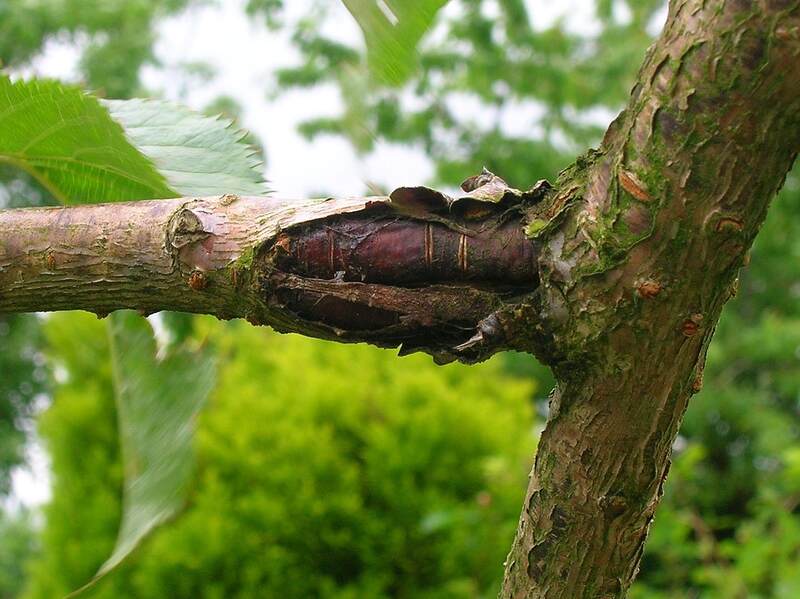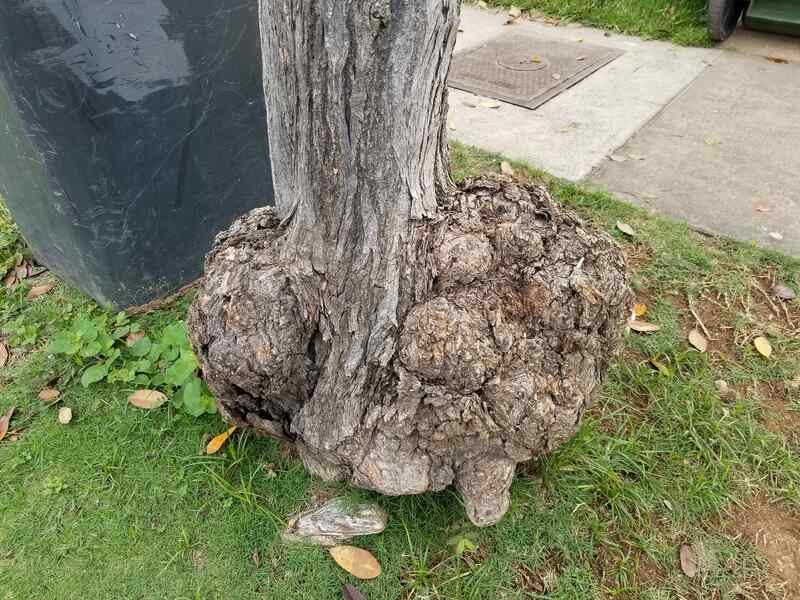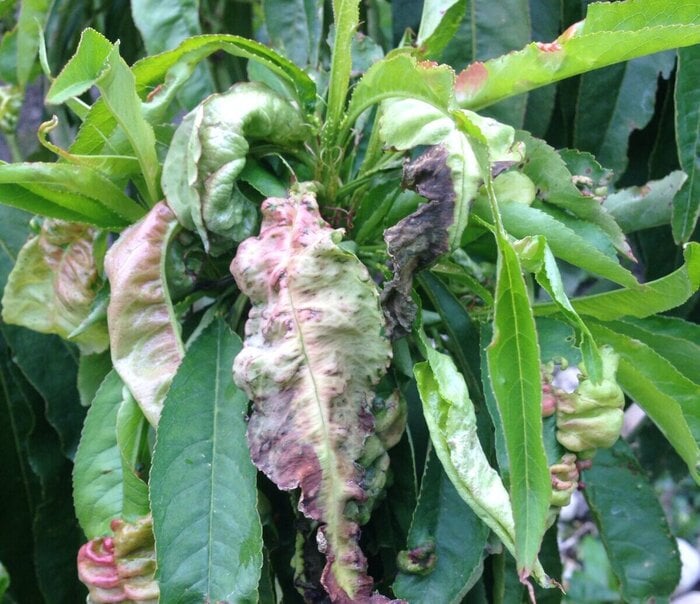
You bite into a juicy peach you just picked from a tree in your yard. Then you notice the spots on the other side of the fruit. It could be bugs, but your tree may also be sick. In this article, we’ll show you how to identify peach tree diseases and how to treat them. That way your trees can look better and perhaps produce that juicy, unblemished fruit you’ve always dreamed of.
Here’s a look at the most common problems you’ll run into with your peaches and nectarines and what to do about them. We’ve also included photos of these peach tree diseases so you can correctly identify them:
1. Bacterial Canker

Bacterial canker causes peach tree bark splitting and weeping cankers on the stems, branches, and trunks. This serious condition can kill your peach tree, especially if lesions appear low on the trunk and cause girdling.
The bacteria destroy or block the phloem, the tissue that carries water and nutrients to all parts of your peach tree. They don’t affect the roots.
Symptoms: Long, oozing cankers form around bud bases and on the trunk and limbs of affected peach trees. Dark, recessed areas of dead plant material have long streaks that reach out into healthy tissue. Affected areas, even the tree itself, may die.
Bacterial canker shows up as small, brown-red dots on fruit and causes deformities and pulp cracking. Diseased tissue under the bark has a characteristic sour smell.
Treatment: When bacterial canker causes peach tree leaves to drop early, apply high-concentration sprays of copper fungicides for peach trees. Prune damaged stems and twigs a few inches behind the canker. For cankers on or near the trunk, get professional help. Avoid spreading the bacteria by working on dry bark and keeping tools sterilized.
Cause: The bacterium Pseudomonas syringae causes bacterial canker.
Risk factors: Peach trees planted in deep, sandy soil or areas with nematodes have an increased risk of infection. Extended periods of warm, wet weather also increase susceptibility. Avoid applying high-nitrogen fertilizer from the middle of June through September. Don’t encourage late fall growth.
Stressed and young peach trees are particularly vulnerable, especially if they have freeze damage or sunburn.
Season: Spring and summer are when the threat is the highest.
Threat level: High. Bacterial canker can lead to the death of your peach tree.
2. Bacterial Spot

Photo Credit: Christine Shimek / Flickr / CC BY-ND 2.0
Bacterial spot can be mild or so severe that you lose your entire peach season. This plant pathology affects leaves, twigs, and fruit. Severe defoliation hurts fruit development and makes buds and wood less able to handle winter weather. Your peaches also may become sunburned or crack due to bacterial spot.
Symptoms: Tiny, purple, black, or brown lesions appear on leaf tips and then migrate to the leaves’ center. Affected areas die and leave holes. Heavily infected leaves turn yellow and fall off your peach tree.
In peaches, bacterial spot shows up as small, olive circular spots that become darker and depressed as the bacteria take hold. The spots may develop cracks, leaving your peaches open to rot.
Treatment: Bacterial spot overwinters in bark cracks, near buds, and in leaf scars. Dormant sprays are essential in the fall to protect the stems of your peach tree. Use a copper-based fungicide spray on the tree’s leaves when they begin to fall.
Cause: The bacterium Xanthomonas arboricola pv. pruni (formerly Xanthomonas campestris pv. pruni) causes this disease.
Risk factors: Peach trees are at higher risk of bacterial spot when planted in nutrient-poor or light, sandy soil and in areas with nematode infestations. Moist, wet conditions above 65 degrees make it easy for bacteria to infect newly emerging leaves or enter through tree wounds.
Season: Infections occur throughout the growing season, but bacteria begin to spread in late winter.
Threat level: Low to high. Bacterial spot can ruin peach crops and is difficult for home gardeners to manage.
3. Brown Rot

Photo Credit: Scot Nelson / Flickr / CC0 1.0
Brown rot, a common peach tree fungus, is a serious infection that affects the fruit, flowers, and shoots. Contamination spreads fast and must be proactively treated.
Symptoms: Brown rot spores infect peach tree blossoms in the spring, moving into shoots and fruit. Flowers wilt and wither, gummy cankers form on twigs, and peaches that develop brown spots quickly rot. Affected fruit becomes spore-covered fruit mummies.
Treatment: Remove infected fruit mummies from trees, as well as any mummies that have fallen to the ground. Prune your peach tree in the winter to remove cankerous areas and ensure proper airflow.
Use fungicides with propiconazole or captan; make sure they’re safe for peach trees. Start spraying at full bloom and repeat twice at 10- to 14-day intervals. Once your peaches begin to change color, start spraying every seven days. You also can use fruit bags to prevent infection.
Cause: The fungus Monilinia fructicola causes brown rot.
Risk factors: A moist, wet environment and overgrown trees are risk factors. Leftover fruit mummies, dead blossoms, and cankers can reinfect trees throughout the growing season. The pathogen can survive the winter.
Season: Brown rot begins at bloom in the spring and can cause many infections throughout the year.
Threat level: Serious without prompt intervention. Brown rot can ruin a peach crop and is labor-intensive to treat. Vectors for reinfection include diseased fruit, flowers, and shoots, which need to be safely removed.
4. Crown Gall

Crown gall is widespread, affecting many plants, including peach trees. Although it probably won’t kill your peach tree, it may cause stunting and problems with fruit production.
Symptoms: Irregularly shaped tumors grow on roots, the crown, and, sometimes, the branches, trunks, and stems. These galls start small and soft, hardening to a woody texture. Infected trees grow slowly and become stunted, leaves may be smaller, and the tree may not bear fruit. Galls can prevent water and nutrients from circulating.
Treatment: Dip peach tree seedlings into an antibacterial wash before planting. Prevention is critical, so avoid injuring trees and practice proper pest control to keep insects that bore at bay.
Causes: The bacterium Agrobacterium tumefaciens causes crown gall.
Risk factors: This disease can contribute to overall poor health or death. It makes your peach tree more vulnerable to wind damage and drought stress. Galls can also kill young peach trees if they become large or numerous. Crown gall likes warm, moist conditions.
Season: Crown gall can infect peach trees at any time.
Threat level: Low.
5. Peach Leaf Curl

Photo Credit: Scot Nelson / Flickr / CC0 1.0
When you see symptoms of peach leaf curl, it’s too late to treat your tree. Like all fungal diseases, this condition thrives in warm, wet climates. The main symptoms appear on peach leaves.
Symptoms: Look for thickened leaves that curl and pucker. Peach leaf curl also can infect fruit and shoots. Swellings appear on the upper side of young peach leaves, turning the affected area red. Leaves fade to yellow and fall to the ground. Compromised peaches have small, white spots that rot.
Treatment: Prevention is the most important tool you have against peach leaf curl. When temperatures warm to 50 degrees, this white peach tree fungus begins reproducing and releasing spores.
Before this happens, treat your trees with a spray containing copper. The best times to spray include in the fall after leaves have dropped and in early spring before buds open.
Cause: The fungus Taphrina deformans causes peach leaf curl.
Risk factors: Risk factors include warm and wet weather.
Season: Peach leaf curl occurs in the spring.
Threat level: Moderate. This disease stunts growth in affected branches and shoots and makes them more vulnerable to frost. Peach leaf curl also damages the fruit.
6. Peach Mosaic
Peach mosaic isn’t endemic, but it can be very serious. This virus spreads via grafting or when affected mites pass the disease to your peach tree.
Symptoms: Delayed leaf growth occurs; small, deformed leaves are folded, exhibit a narrow profile, and have a mottled-yellow coloring with a mosaic pattern. Streaking and color blocking occur in blossoms. Any fruit that develops becomes lumpy and small, and the yield is low.
Treatment: No treatment exists for this disease. Infected trees may survive for a few seasons but never bear viable fruit.
Cause: The peach latent mosaic viroid causes its namesake disease.
Risk factors: This condition is spread by the peach bud mite and infected grafts.
Season: Peach mosaic usually occurs because of grafting or during the spring.
Threat level: High, if mites are not suppressed.
7. Peach Scab

This fungal disease can affect a small number of your peaches or completely destroy your season. Infection occurs in spring, but symptoms don’t show until much later.
Symptoms: Raised spots affect fruit, leaves, and shoots.
Treatment: By the time peach scab spots appear, it’s too late to treat. Proactively spray your peach tree about two weeks after the flowers drop. Use a sulfur or captan fungicide. Spray three times, with seven to 10 days between applications.
Cause: The fungus Cladosporium carpophilum causes peach scab.
Risk factors: Your peaches might be smaller than expected and more susceptible to other diseases.
Season: This disease occurs in the spring.
Threat level: Low to moderate. In severe cases, your peach crop may be lost to secondary infections, cracking, or rot.
8. Powdery Mildew

Photo Credit: Miyuki-3 / Canva Pro / License
Powdery mildew generally affects green fruit but can also show up on leaves and new shoots. It often spreads to peach trees from rose bushes and apple trees.
Symptoms: Patchy, white circular spots appear on green fruit. Affected areas become brown and leathery and can crack, leaving your peaches vulnerable to secondary infection and rot. Powdery mildew deforms leaves.
Treatment: Remove diseased plant parts when pruning. When blossoms drop, apply a general fungicide.
Causes: The fungus Sphaerotheca pannosa causes powdery mildew.
Risk factors: Nearby rose bushes and apple trees are common disease vectors for this fungal infection. Powdery mildew likes warm, wet conditions.
Season: Spring is the season for this disease.
Threat level: Low. The powdery mildew fungus overwinters on shoots and leaf bud scales, causing new infections in the spring.
9. Rust

Is your peach tree dropping leaves early? If they’re peppered with small, yellow dead spots, you probably have a fungal peach rust outbreak.
Symptoms: Bright yellow, angular spots on leaves eventually cause leaves to drop prematurely. Look for rust-colored spore masses. Rust may also affect fruit, producing cankers with powdery rust-brown spores.
Treatment: Apply sulfur-based or sterol-inhibiting fungicides in the spring.
Cause: The fungus Tranzschelia discolor causes rust.
Risk factors: This disease likes warm, moist weather.
Season: Rust occurs in the summer and fall.
Threat level: Low. Rust may contribute to secondary infections in your peaches.
10. Shot Hole Blight

Photo Credit: William M. Brown Jr., Bugwood.org / Forestryimages / CC BY 3.0 US
Shot hole blight disease affects peach trees and other fruit trees. Leaves, twigs, and buds develop lesions, with the leaves falling from the tree. Sometimes these unsightly lesions also appear on fruits.
Symptoms: Small, BB-sized spots on leaves start out dark purple, becoming brown in the center and retaining a purple border. Dark, sunken swellings in the center of each spot release spores, spreading the infection. In wet weather, your peaches may develop similar spots. The flesh is hard and pithy around affected areas.
Treatment: Preventative peach tree fungicide should be sprayed in the fall, right after leaf drop, or in the spring, before buds open. Copper and zinc sulfate are effective.
Cause: The fungus Wilsonomyces carpophilus causes shot hole blight.
Risk factors: Warm, moist conditions are the type of weather that this disease of peaches prefers; other risk factors include trees that aren’t thinned for proper airflow and irrigation that wets leaves. This disease can overwinter in old lesions.
Season: Shot hole blight appears during the spring.
Threat level: Moderate. This disease blight may destroy the entire season’s fruit harvest.
11. Gummosis

Fungal gummosis is a peach disease that attacks the tree’s vascular system, impairing its growth. It affects the plant’s bark, shoots, and leaves.
Symptoms: The first signs of gummosis are blisters that appear in young shoots and near wounds. A characteristic resinous sap (gum) oozes out from the lesions on the bark. The vascular clogging causes cankers and the shoots and leaves will turn yellow and die.
Treatment: Unfortunately, there are no approved fungicides to control peach fungal gummosis. The best approach is to prevent: Use a peach fungicide to protect your crop and combine it with good cultural practices. Remove dead wood during winter pruning, since the pathogen produces its spores in diseased or dead wood.
Cause: Gummosis is caused by the Botryosphaeria dothidea pathogen.
Risk factors: Water stress and poor management of the trees can make them susceptible to gummosis.
Season: This disease can infect peach trees almost all year round, but symptoms are usually more visible in the fall or spring.
Threat level: Moderate to high. Since there is no fungicide available, the disease can establish itself in the tree. Once it progresses, fungal gummosis becomes harder to control, eventually leading to death.
FAQ
What General Strategies Can I Use to Deal with Peach Diseases?
According to The Connecticut Agricultural Experiment Station, a four-pronged approach can be used to help prevent or manage peach tree disease:
- Resistant tree varieties: Planting fruit tree cultivars with genetic resistance will reduce or eliminate the likelihood of that disease.
- Culture: This includes performing tasks, including fertilizing and pruning, that can minimize tree stress.
- Sanitation: Removing any dead and diseased tree parts and fruits
- Use of pesticide sprays
Can Pruning Help with Diseases of Peach Trees?
Yearly pruning can help air circulation, reduce pest problems, and improve the longevity of the peach tree. You should prune dead or broken branches, as well as branches that rub against each other, which can wound the tree, letting diseases enter.
You’ll also need to prune the peaches themselves. You should shoot for only one peach every 6-10 inches but not until after the June drop, when the tree naturally drops part of its fruit load.
What Bugs Can Damage my Peach Trees?
Damaging insects include plum curculio, tarnished plant bugs, Oriental fruit moth, and peachtree borers. Insecticides can usually be used to control these pests.
- The females of the plum curculio, one of the most damaging of peach tree insects, chew into the skin of developing fruit to insert eggs. Smaller fruit falls, but larvae remain in larger fruit. Picking up and destroying fallen fruit can help control this pest.
- Tarnished plant bugs pierce and feed on blossoms and fruit and cause deformities, shallow depressions, and fruit drop. To help control this pest, control weeds, especially wild mustard.
- The larvae of the Oriental fruit moth invade the shoot tips and stunt growth and, ultimately, fruiting. To help get rid of this insect, prune out and destroy wilted tips 6 inches below any visible damage.
- Peachtree borer larvae burrow through the bark of peach trees at the base of the tree. Insecticides can help treat these pests.
When to Call a Tree Care Expert
Besides giving you fresh fruit to enjoy every year, peach trees boost the value of your property. Make sure your trees are the peachiest by bringing in certified arborists to check for diseases and problems in the soil and to treat any tree issues.
LawnStarter puts you in touch with respected arborists and tree care pros in your area. Enter your ZIP code and get a vetted list of tree care companies to keep your peach cobbler source healthy for years to come.
Main Image Credit: Pixabay